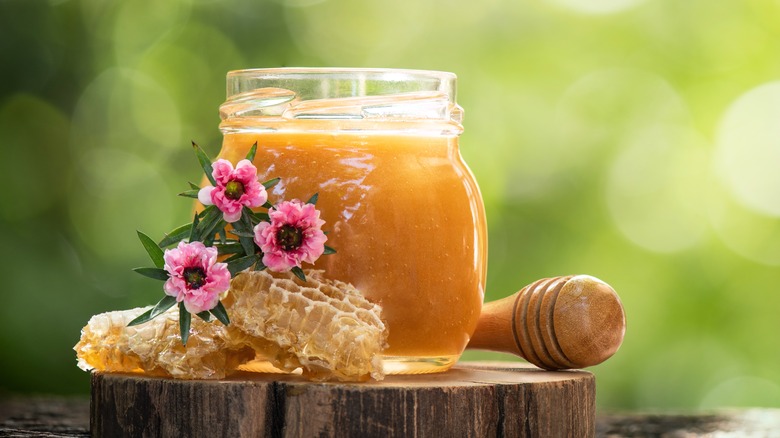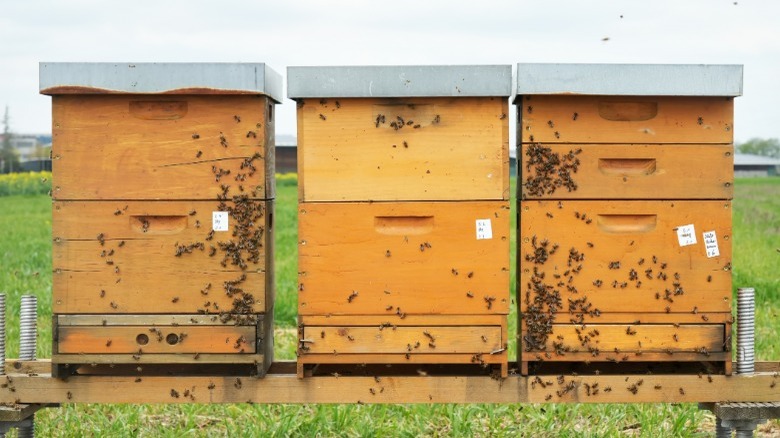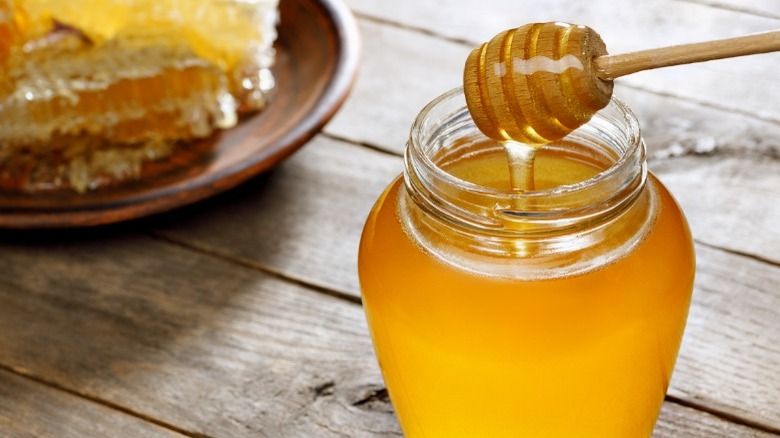The Biggest Difference Between Wild And Raw Honey
Honey is such a versatile ingredient, whether it's added to your morning lattes or drizzled over a bowl of oatmeal. You can even grill with honey for a delicious sweet and savory coating on meats, vegetables, and more. But when you go to a grocery store to buy a new bottle of honey, you may be overwhelmed by the seemingly never-ending varieties on the shelves. Beyond the familiar clover honey sold in bear-shaped squeeze bottles, you can find honeys made from all kinds of different flowers, as well as ones that are harvested and processed in different ways.
"Wild" or "raw" are two adjectives commonly seen on honey labels, and the terms are less than self-explanatory. You might wonder if there's even a difference between the two. As it turns out, wild honey is actually a subset of raw honey. Broadly speaking, raw honey is unprocessed and retains many of the important nutrients that the natural sweetener can provide. These vitamins and other nutrients can be lost when honey is heavily processed. The category of raw honey can be further divided into two varieties: wild and farm. Wild honey is produced, as the name suggests, out in the wild, in naturally-occurring beehives in trees.
Farm vs. wild honey
If wild honey is raw honey, what makes the wild version so unique that it merits its own catergory? The big discrepancy here is where each kind of honey is produced. Unlike wild honey that can be harvested from naturally-occurring hives, farm honey is made industrially, produced by bees in bee boxes with the help of beekeepers.
Wild honey also has visual and taste-based traits that differentiate it from its farm-made sibling. The flavor of wild honey will change based on the location of the hive. Because it's made solely by wild bees and doesn't undergo intense processing, evidence of the insects' hard work could also be found in the honey. This includes everything from pollen to honeycomb bits and even fragments of the bees' wings.
Wild honey is also cloudier and can crystallize easily, so it doesn't always look as appealing as that perfectly golden honey in the little bear-shaped bottle. However, wild honey makes up for it in the form of unique flavors, not to mention it's favored by those of us who prefer less processed foods. Both raw and wild honey products offer singular tastes such as earthy and grassy alfalfa honey, bold and dark buckwheat honey, or lightly citrusy orange blossom honey, all in their most natural forms.
What about processed honey?
Nutrition-concerned consumers may wonder if processed honey is as good for you as raw honey. The answer is probably not. According to Healthline, raw honey retains significantly more of its nutrients than processed honey. Processing the sugary substance can include steps such as filtration and pasteurization, and these methods remove many nutrients. Additionally, processed honey is often bulked up with sugars, extra sweeteners, or flavorings that raw honey is not allowed to have.
Raw honey has a number of health benefits that the processed version can't brag about. These include essential minerals, amino acids, and antioxidants that have been linked to anti-inflammation and lower rates of cancer and other diseases. Additionally, the bee pollen found in raw honey has a number of health benefits connected to reducing inflammation, heart disease, strokes, and improving liver function.
You may have also heard that ingesting raw honey helps to mitigate allergy symptoms. Although studies have been done on this idea, there isn't a ton of strong evidence that the pollen in honey can make you less sensitive to the pollen in your environment. Still, wild honey is worth trying to get more nutrients out of your honey and experience the unique taste of specific forest environments.



